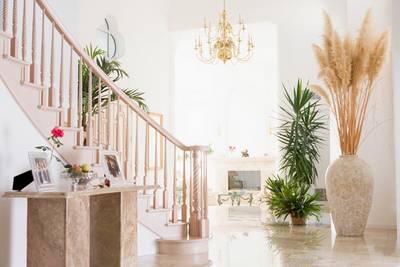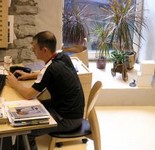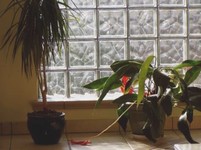Last updated on February 8th, 2018 at 01:16 am
 Interior Landscape Design:
Interior Landscape Design:
How to Create Your Own Indoor Garden
by Jane Lake
 Most of us live in homes somewhat short of perfection – window views may be bleak or uninspiring; kitchens and bathroom, for all their functionalism, may seem cold or antiseptic. Even the most elegantly appointed living rooms may lack vitality and visual warmth. However, add a lush window, a pot rack dripping in herbs and saucepans, or a jungle of decorative foliage and an ornamental specimen tree – in short, an indoor garden – and the impact is immediate and dramatic. A stark interior can become a verdant landscape, warmed by tropical greenery, alive with design possibilities limited only by the imagination and dedication of the indoor gardener or professional interior landscape designer.
Most of us live in homes somewhat short of perfection – window views may be bleak or uninspiring; kitchens and bathroom, for all their functionalism, may seem cold or antiseptic. Even the most elegantly appointed living rooms may lack vitality and visual warmth. However, add a lush window, a pot rack dripping in herbs and saucepans, or a jungle of decorative foliage and an ornamental specimen tree – in short, an indoor garden – and the impact is immediate and dramatic. A stark interior can become a verdant landscape, warmed by tropical greenery, alive with design possibilities limited only by the imagination and dedication of the indoor gardener or professional interior landscape designer.
There”s a world of difference between buying a few plants from the grocery store to place randomly here or there and planning an indoor garden meant to complement, enhance or modify existing interior design. A successful indoor garden combines the principles of interior decorating with sound horticultural practices. If you have a green thumb and an eye for design, it”s possible to create your own growing, ever-changing landscape in one room, or in every room, of your house.
Whether you opt for do-it-yourself of hire a designer, always buy plants from a specialist, advises interior landscape designer Linda Fairburn, president of The Plant Lady in Waterloo, Ontario. A reputable supplier will offer you top grade, healthy plants along with advice on the care and environment. “There a difference in quality between mass-produced plants, grown in high-light levels with poor insect control, and commercially-grown plants, which are partly acclimatized, with reduced fertilizer levels and stringent pest control,” she explains. “Commercially grown plants are more likely to survive in the long-term.”
 If you work with a designer, make sure he or she knows enough about your lifestyle, as well as the look you want to achieve, before the final plant selection is made, recommends Paul Schaefer, owner of Jenkins Indoor Landscape in Kitchener. “How much you entertain, how much space you have to dedicate to plants, and environmental conditions such as lighting, heating and air-conditioning are all aspects to consider. Also important is the selection of containers, which may be as simple as plastic or contemporary fibreglass or as elaborate as exotic ceramics, hand-turned clay pots, wicker or brass,” he says.
If you work with a designer, make sure he or she knows enough about your lifestyle, as well as the look you want to achieve, before the final plant selection is made, recommends Paul Schaefer, owner of Jenkins Indoor Landscape in Kitchener. “How much you entertain, how much space you have to dedicate to plants, and environmental conditions such as lighting, heating and air-conditioning are all aspects to consider. Also important is the selection of containers, which may be as simple as plastic or contemporary fibreglass or as elaborate as exotic ceramics, hand-turned clay pots, wicker or brass,” he says.
 Of the five essential growth factors needed for plants – warmth, light, water, air and food – perhaps none is more crucial than the light levels in your home. “Lighting more than anything will dictate the range of your plant selection,” Fairburn says. “However, within that range will be design choices of color, texture, size and shape, with interesting variances within a plant species.”
Of the five essential growth factors needed for plants – warmth, light, water, air and food – perhaps none is more crucial than the light levels in your home. “Lighting more than anything will dictate the range of your plant selection,” Fairburn says. “However, within that range will be design choices of color, texture, size and shape, with interesting variances within a plant species.”
Experienced designers can offer you plants to fill every dark corner or dimly-lit nook. Although artificial plant lighting can be useful, it”s expensive to install in existing homes and is therefore more applicable to new home construction.
Installing house plants en masse is a challenging task, requiring time and commitment to maintain if you want your plants to survive. Since costs can easily reach into thousands for a full-scale indoor garden projects, consider protecting your investment by hiring a bonded professional to do it all for you – consultation, installation, service and maintenance of the plants on a routine weekly basis. An annual service contract usually includes watering, feeding, cleaning foliage and pruning of plants, treatment of pests and diseases, and a replacement guarantee for any plant that dies.
 Well-made silk plants, virtually indistinguishable from the real thing, are a practical option, either used alone or mixed with real plants. Silk plants are cheaper, remain beautiful for years, work in areas where live plants won”t – and generally need little more maintenance than cleaning with a feather duster.
Well-made silk plants, virtually indistinguishable from the real thing, are a practical option, either used alone or mixed with real plants. Silk plants are cheaper, remain beautiful for years, work in areas where live plants won”t – and generally need little more maintenance than cleaning with a feather duster.
Silk plants are recommended for out-of-the-way places such as cathedral ceilings or two-storey atriums, where accessibility is a problem, or for environmentally harsh areas such as hallways. Although purists may balk at the idea, silk plants do offer flexibility, easy care, and an astonishing choice of variety and color.
Flowering plants make a tempting addition to an indoor garden. Foliage varieties, whether chosen for leaf form, color, texture or growing habits are the mainstay of indoor gardens simply because they will maintain a consistent appearance.
As a design element, foliage plants can soften the look of a room and help disguise architectural defects; a specimen tree or plant grouping could visually separate an open-plan living and dining area, for instance, or a high-beam ceiling could be “lowered” with hanging plants. On the other hand, improperly placed plants will accentuate trouble spots.
Scale is all-important in indoor landscape design: a towering Ficus bejamina (weeping fig) would dwarf a small den; likewise, a solitary fern would be lost in a spacious living room. The experts suggest using single specimen plants to make a statement – they are usually larger, more stable species, with a lot of drama. One exception is hanging plants – from a design perspective, two smaller hanging plants, grouped together, with varying height, offer more impact than a larger hanging plant hanging alone.
Creative placement of plants in your home can transform nondescript alcoves and niches, halls and stairways, and visually brighten “dead” areas such as fireplaces in summertime. Even an empty wall becomes a design asset when used in indoor garden planning.
Windows, of course, are a natural site for plants. Use plants here to create a break from indoors to outdoors, or use a tiered foliage grouping to make undesirable window views recede. Try linking interior to exterior by matching indoor plants with those grown directly outside your window. Give bay windows or glass walls the treatment they deserve, installing plants of important size, grouped with an eye for overall effect. Resist the urge to clutter such valuable sun-lit space with a myriad of tiny-potted specimens.
A common mistake among plant collectors is that they collect for the sake of it, with little thought given to incorporating individual plants as part of an interior visual whole. With the enormous array of house plants available today, there”s a plant or plant grouping for every design purpose. A well-planned interior landscape can reflect your personality, improve your home and create just the right mood, whether you want to dazzle or soothe, astonish or delight.
First published in Highlights Lifestyles Magazine Copyright © 2005 -2018 Jane Lake All Rights Reserved
